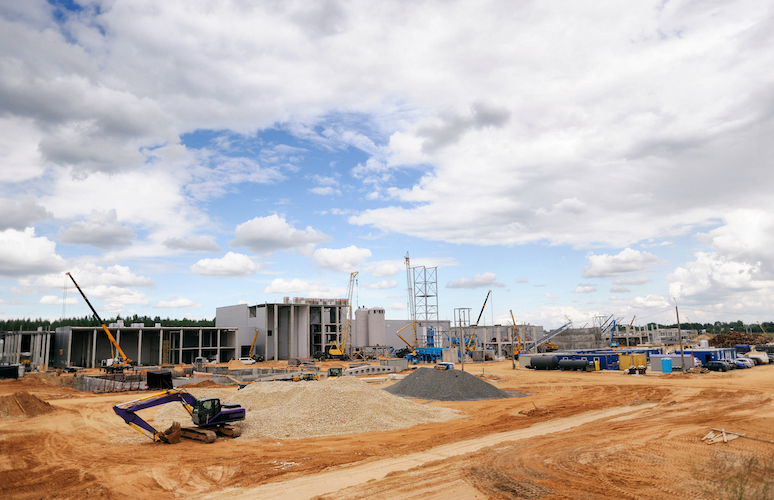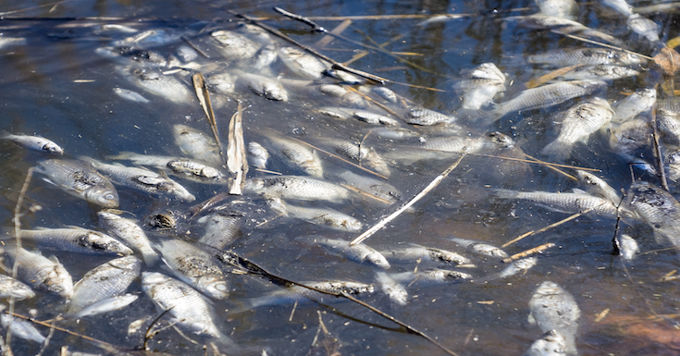
Stormwater Requirements and Erosion and Sediment Control Requirements at Construction Sites in Virginia
Nature of the requirements
Besides managing the complexity that is part of the construction project, the general contractor at a construction site is also dealing with two sets of very important environmental requirements. One is the stormwater requirements; the other is the erosion and sediment control requirements. The goal of the stormwater program is to prevent the rainwater that falls on the construction site from picking up chemicals and then forming into a streamlet of runoff that carries those chemicals into our waterways. The goal of the erosion and sediment control program is to control the tendency of rainwater to carry sediment from the construction site into our waterways. So, two separate programs with two separate goals.
Why do we need any of these requirements?
The short answer is that the federal Clean Water Act, adopted by the U.S. Congress in 1987, requires stormwater controls at construction sites in all 50 states, including the Commonwealth of Virginia. I explained how and why these requirements came about in the Stormwater Regulations At Virginia Construction Sites article I published earlier this month.
Okay, but are there good reasons for the stormwater requirements?
On the stormwater side, toxic chemicals carried into our waterways end up in the food chain where they make their way into the bodies of the small animals in the food chain. The small animals that ingest these chemicals are the food for the larger animals. If the chemicals kill the smaller animals, fishermen will find and catch fewer stripers because the striper population will plummet if deprived of its food source. As bad as it sounds, that is the best-case scenario. The worst-case scenario comes about if the toxic chemicals do not somehow kill the little animals, in which case the striper eat them, and then fishermen catch and eat the striper. When this happens the risk of cancer and other illness migrates into our bodies owing to the toxic chemicals that entered the food chain when that stormwater, laden with oils, paints, or wastewater from washout of concrete, stucco, or other construction materials, flowed from the construction site.
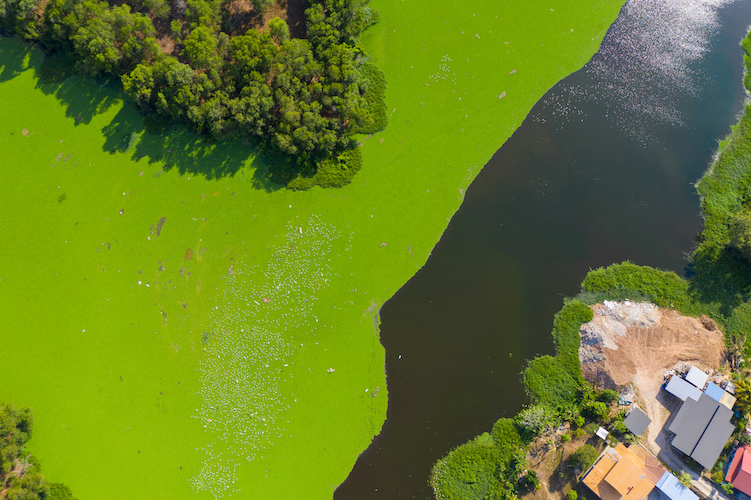
SWPPP’s in many areas of Virginia focus on phosphorous reduction as a means of reducing the prevalence of algae blooms, such as the algae bloom shown in this photo. (Alen Thien / Shutterstock.com)
Stormwater controls are tailored to specific local needs. In the Hampton Roads area of Virginia, and the other areas of Virginia that border the Chesapeake Bay, a local priority is to reduce or eliminate the occurrence of harmful algae blooms that form in the waters of the bay. Algae bloom blocks sunlight from reaching organisms that need sunlight to live. Algae blooms also suck all the oxygen from the water resulting in massive fish kills, and they spur the growth of toxic phytoplankton that poison aquatic life. Algae blooms are fueled by excessive amounts of nitrogen and phosphorous in our waterways. Of the two, phosphorous is thought to be easier to control. Since algae blooms require both, the elimination of one prevents formation. As between nitrogen and phosphorous policymakers rightly or wrongly-placed their bullseye on the latter. Leaving toxic chemicals to one side, then, the stormwater regulations applicable in these specific regions of Virginia typically employ aggressive strategies to try to reduce the release of phosphorous from construction sites.
As the Virginia DEQ explains: “Unmanaged stormwater can cause erosion and flooding. It can also carry excess nutrients, sediment, and other contaminants into rivers and streams. Properly managed stormwater can recharge groundwater and protect land and streams from erosion, flooding, and pollutants.”
Are there good reasons for the erosion and stormwater sediment control requirements?
The Virginia Erosion and Sediment Control Handbook (3rd ed. 1992) page II-2 tells us that soil erosion is the process by which the land’s surface is worn away by the action of wind, water, ice, and gravity. Sediment “silts in” creeks and channels resulting in loss of deep water access at waterfront properties. The Chesapeake Bay Foundation explains that water polluted with sediment becomes cloudy, preventing animals from seeing food. It also prevents natural vegetation from growing in water. It destroys the habitat where the smallest organisms live, causing massive declines in fish populations. Underwater grasses in the Chesapeake Bay, known also as subaquatic vegetation, provide wildlife food and habitat, add oxygen to the water and absorb nutrient (i.e. nitrogen and phosphorous) pollution. Yet, these grasses cannot grow in water clouded with sediment pollution.
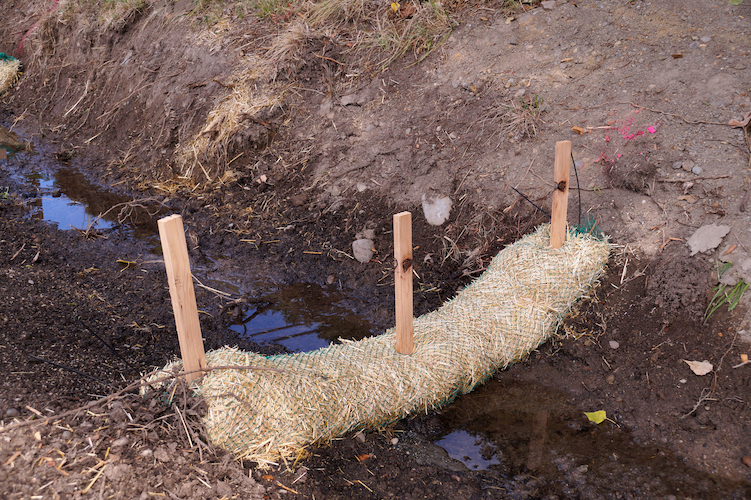
A bio log used to control erosion at a construction site. (Vladdon / Shutterstock.com)
As noted in VESC Handbook page I-1 “The typical construction site erodes at a rate of up to 100,000 tons per square mile per year. This rate is 200 times greater than erosion from cropland and 2,000 times greater than erosion from the woodland.” Referring again to VESC Handbook page II-8, the erosion and sediment threat is greatest during construction. There is a dramatic decrease once development is complete. Construction sites are a good place to start if we want to keep sediment from pouring into our waterways.
How do the stormwater rules control toxic chemicals from leaving the construction site?
The stormwater rules require the owner to obtain a permit before commencing ground disturbance activities. The construction general permit (CGP) is a popular option, with the more expensive (and more time-consuming) individual permit being available in those situations where the project cannot qualify for the CGP. The permits employ strategies that minimize stormwater runoff from the site and strategies that avoid sullying the stormwater through exposure to chemical substances. A sampling of these strategies include requiring the owner to calculate the sources and amounts of runoff, requiring the owner to manage the quantity of runoff with earthen features (such as bio-retention, grass swales, earthen embankments, retention basins (described in the Virginia Stormwater Management Handbook) and with other features (e.g., hay bales), requiring the owner to avoid contaminating stormwater by preventing it from coming into contact with harmful substances (e.g., preventing leaks and spills at the site, placing plastic sheeting or a temporary roof to shield soaps, solvents, and wash water from rain), and requiring the owner to train construction personnel at the site to raise the level of their pollution prevention awareness.
The legal structure follows the model seen time and again in most environmental laws, federal and state. Virginia built its stormwater control program, and its erosion and sediment control program, by enacting a broadly worded statute for each, which furnishes the overall framework and then requiring the Virginia Department of Environmental Quality to follow up with a detailed set of regulations for each.
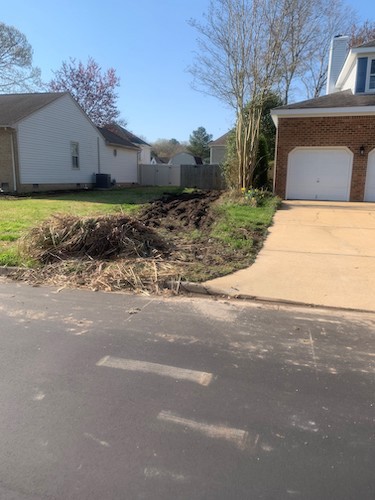
Vehicles “track” sediment off the construction site if there is no stone pad or mulch at the vehicle ingress/egress point.
The Virginia Stormwater Management Act
The Virginia Stormwater Management Act is codified at Virginia Code §§62.1-44.15:24 to :50.
The key sections of the act include the definitions section (Virginia Code §62.1-44.15:24), the section granting broad authority to the State Water Control Board to permit, regulate and control stormwater runoff (Virginia Code §62.1-44.15:25), the section mandating that certain localities establish and operate the Virginia Stormwater Management Program (VSMP) while allowing other localities the option of running the VSMP or opting out in which case the DEQ will operate the VSMP in that locality (Virginia Code §62.1-44.15:27), the section authorizing the State Water Control Board to adopt regulations that establish standards and procedures for administering the VSMP (Virginia Code §62.1-44.15:28), the section with the cornerstone prohibition forbidding persons from conducting land-disturbing activity prior to obtaining approval from the VSMP authority (Virginia Code §62.1-44.15:34(A)), the section listing activities that are exempt from the act, such as land clearing for agriculture and land-disturbing activities less than one acre unless the site is within a Chesapeake Bay Preservation Area in which case the exemption is for areas less than 2,500 square feet (Virginia Code §62.1-44.15:24 (C)), the section requiring the VSMP authority to inspect construction sites, provide notice of noncompliance and a deadline for corrective action, and to issue a stop work order if corrective action not timely completed (Virginia Code §62.1-44.15:37), the section authorizing the regulator to bring the violator to court to impose a monetary civil penalty or obtain an injunction (Virginia Code §62.1-44.15:42), the section authorizing a person “aggrieved” to obtain a formal hearing before the State Water Control Board (Virginia Code §62.1-44.15:44), the section authorizing a person “aggrieved” to bring a lawsuit in Circuit Court (Virginia Code §62.1-44.15:46), and the section exposing violators to civil penalty of up to $32,500 per day for each violation or criminal prosecution with incarceration up to 15 years (Virginia Code §62.1-44.15:48).
The Virginia Stormwater Management Program Regulation
The VSMP regulation is codified at 9 VAC 25-870-10 to 9 VAC 25-880-100.
The key passages are the section that lists the requirements of the stormwater pollution prevention plan (including, among other things, an erosion and sediment control plan, a stormwater management plan, and a pollution prevention plan) (9 VAC 25-870-54), the section that gives the requirements for the stormwater management plan (9 VAC 25-870-55), the section listing the requirements for the pollution prevention plan (9 VAC 25-870-56), the section requiring DEQ to review each “opt-in” locality (i.e. a locality that has opted to run the VSMP) at least once every five years (9 VAC 25-870-144), the section describing enforcement of state-issued permits in “opt-out” jurisdictions (9 VAC 25-870-660), and the section that provides the Construction General Permit (CGP) (9 VAC 25-880-70)
How do the ESC rules prevent sediment from leaving the construction site?
Of the various causes of erosion (e.g. wind, water, ice, and gravity) the VESC handbook on page II-2 confirms that “water-generated erosion is unquestionably the most severe type of erosion.” Raindrops falling on bare soil dislodge soil particles and splash them into the air, which makes these detached particles available to be carried away. Strategies to prevent erosion are to install the vegetative cover, avoid creating a steep slope (and, if one must be created “roughen” it with a cleated dozer), install a perimeter barrier to trap the sediment within the boundary of the construction site, install a rock pad or layer of mulch at vehicle ingress/egress points to stop vehicles from “tracking” sediment off-site, and install sediment traps or barriers at storm drain inlets. The erosion and sediment control plan is a document that explains and illustrates the particular strategies tailored to the individual construction site. It consists of two parts: (i) a narrative; and (ii) the site plan.
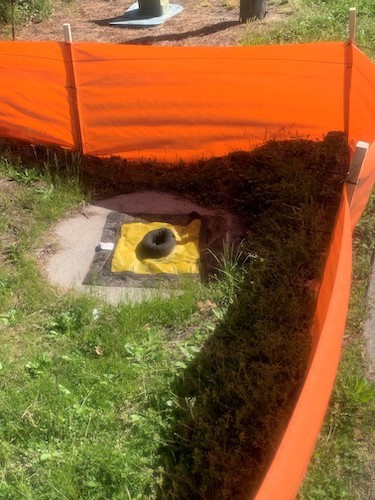
Inlet protection at a storm drain, and silt fence, on a construction site
Virginia built its erosion and sediment control program through a broadly worded statute, known as the Virginia Erosion and Sediment Control Law (VESCL), which furnishes the overall framework. The VESCL requires the Virginia Department of Environmental Quality to follow up with a detailed set of regulations.
The Virginia Erosion and Sediment Control Law
The VESCL is codified at Va. Code §62.1-44.15:51 to §62.1-44.15:66. Unlike the stormwater control program, which allows localities to decide whether the locality or the state will administer the stormwater control program when it comes to the erosion and sediment control program, the localities are mandated by Va. Code §62.1-44.15:51.1 to “adopt and administer a Board-approved” Virginia Erosion and Sediment Control Program (see also Va. Code §62.1-44.15:54(A)).
The key passages of the VESCL are the definitions (Va. Code §62.1-44.15:51) (especially the definition of land-disturbing activity which triggers the act when the disturbance affects at least 2,500 square feet in a Chesapeake Bay Preservation Area or at least 10,000 square feet outside of such area), the delegation of authority to the State Water Control Board to develop regulations that provide “for the effective control of soil erosion, sediment deposition, and nonagricultural runoff” (Va. Code §62.1-44.15:52), the prohibition that “no person shall engage in any land-disturbing activity until he has submitted to the VESCP authority an erosion and sediment control plan for the land-disturbing activity and the plan has been reviewed and approved” (Va. Code §62.1-44.15:55), the requirement that regulators periodically inspect the land-disturbing activity to determine compliance with the plan (Va. Code §62.1-44.15:58), the requirement that regulators deliver an inspection report to the owner or permittee following completion of that inspection (Va. Code §62.1-44.15:58), the requirement that when the regulator finds deficiencies he or she delivers a notice to the owner or permittee specifying “measures needed to comply” and a deadline for coming into compliance or an order that land-disturbing activities be stopped (Va. Code §62.1-44.15:58), and the ability of the regulator to bring the violator to court to impose a monetary civil penalty or obtain an injunction (Va. Code §62.1-44.15:63).
Is it true that the stormwater rules and the erosion and sediment control rules are about to be merged into a unified set of rules?
There is a lot of overlap between the stormwater rules and the erosion and sediment control rules. It is hardly surprising that during its 2016 session the General Assembly adopted House Bill 1250 and Senate Bill 673 which will eventually combine the Virginia Stormwater Management Act and the Virginia Erosion and Sediment Control Law to create the Virginia Erosion and Stormwater Management Act. The new law becomes effective only after the State Water Control Board adopts regulations that consolidate the two programs. The DEQ in December 2018 issued a Notice of Intended Regulatory Action for the rulemaking to create those regulations. I expect that the DEQ will issue draft regulations for public comment in late 2021 with a view toward presenting final regulations to the State Water Control Board for approval at some point in 2022. Once the new regulations take effect the Virginia Erosion and Stormwater Management Act will supersede and replace the Virginia Stormwater Management Act and the Virginia Erosion and Sediment Control Law.
What are the typical violations that regulators find when they inspect a construction site?
For stormwater, the common violations that regulators find during inspection can best be described as the failure to document the good housekeeping practices required by the CGP.
- The stormwater pollution prevention plan (SWPPP) is not available onsite when there is activity onsite.
- Logs for grading activities and stabilization are not up to date.
- The site map fails to track the location of construction activities as they change over the life of the construction project.
- The strategies that minimize stormwater runoff from the site are called “best management practices” (BMPs). BMPs used to manage the quantity of runoff may sometimes include earthen features such as bio-retention, grass swales, earthen embankments, retention basins. Another commonplace violation is the failure to track the location of these BMPs as the construction activities change over the life of the construction project.
- Failure to document modifications and amendments to the SWPPP.
- Pollution prevention plans are not specific to the work onsite.
For erosion and sediment control the common violations that regulators find during an inspection are the failure to follow the approved ESC plan.
- Failure to install controls per the approved plan.
- Failure to install controls per the phasing or sequencing outlined in the approved plan.
- Failure to appropriately modify the approved plan when problems are encountered.
- When alternative ESC controls are used, the failure to get approval from the local VESCP authority, and the failure to update the SWPPP to document the change.
- The failure to maintain ESC controls in accordance with the approved plan.
Active Construction Site (Banksy Boy / Shutterstock.com)
How do the regulators enforce the stormwater and the ESC regulations at construction sites?
As is true with most (if not all) legal programs designed to shape human behavior, the stormwater and ESC programs are more likely to bring about the desired result if the cost of violation, together with the likelihood of being “caught”, exceeds the time, effort and attention needed for full compliance. The construction site is open to inspection and enforcement by the local government, the DEQ, and the EPA, with a regulator typically visiting the construction site on a weekly basis.
When violations are found the regulators respond with a menu of options that fall along a continuum. The least intrusive comes in the form of administrative action that involves written identification of the discrepancies together with a written demand to remedy the noncompliance no later than a specified deadline. This is typically accomplished through the medium of the inspection report that the regulator issues to the responsible person at the construction site at the conclusion of the inspection. If a stronger response is needed, the regulator can issue a warning letter or an attention-grabbing stop-work order. A stop-work order is highly disruptive – and costly – at a construction project. For this reason, owners and general contractors are keen to avoid them. Perhaps also owing to the pain that the stop-work order inflicts on owners and general contractors, the regulators only rarely find it necessary to move up the continuum to invoke more powerful tools such as civil enforcement, or to the enforcement tool of greatest effect, that being criminal enforcement.
On completion of the inspection, the regulator issues an inspection report. The owner, the general contractor, and the others working at the site often are focused on meeting the challenges of getting the project built. Updating the SWPPP can get lost in the hurry to meet project deadlines. This type of minor violation will result in an inspection report with a corrective action deadline, typically 7 days. A major violation will trigger a vastly different response.
An owner who commences land-disturbing activity without an approved ESC control plan and without a VSMP permit, and who causes offsite environmental damage (a fish kill, for instance), will likely receive a stop-work order and face criminal prosecution that will place him or her in jeopardy of jail time, a fine, and the entry of a conviction on his or her record.
Between these two extremes, there is a middle ground enforcement tool known as civil enforcement. The warning letter is the first indication that the regulator is close to initiating civil enforcement. Prompt compliance after receipt of the warning letter will avoid further escalation. The failure to appropriately respond to the warning letter typically results in the issuance of a Notice of Violation (NOV), which signifies that the process has moved out of the compliance arena and into the enforcement process. The NOV is a demand for payment of a monetary sum (the civil penalty) and entry into a consent order. Refusal will bring about court action to recover the civil penalty and to obtain an injunction.
The DEQ’s December 19, 2018, Guidance Memo No. 18-2012 establishes a point system that helps regulators fashion a response that is proportionate to the violation. It is specific to violations of stormwater permits at construction sites in Virginia, and offers the following:
Point value < 2 Written notice in the inspection report
Point value > 2 but < 4 Warning Letter
Point value > 4 Notice of Violation
Most violations found during the inspection are handled administratively, within the compliance system. Stop-work orders are issued occasionally, but not frequently. Civil enforcement is more infrequent still and criminal prosecution is used only rarely.
The criminal penalties available in the Virginia Stormwater Management Act (Virginia Code §62.1-44.15:48) are
- Willful or negligent violation: misdemeanor (12 mos / $2,500 to $32,500)
- Knowing violation: felony (1-3 yrs / $5,000 to $50,000)
- Knowing violation that places another person in imminent danger of death or serious bodily harm: felony (2-15 yrs / up to $250,000)
The criminal penalties provided in the Virginia Erosion and Sediment Control Law are
- Class 1 misdemeanor
- 12 months
- $2,500 fine
Contact Jim Lang if you would like to see him publish more information on stormwater permits or erosion and sediment control permits in the state of Virginia. Of course, you can always contact Jim for his advice and assistance in connection with any specific needs in your particular construction project.
